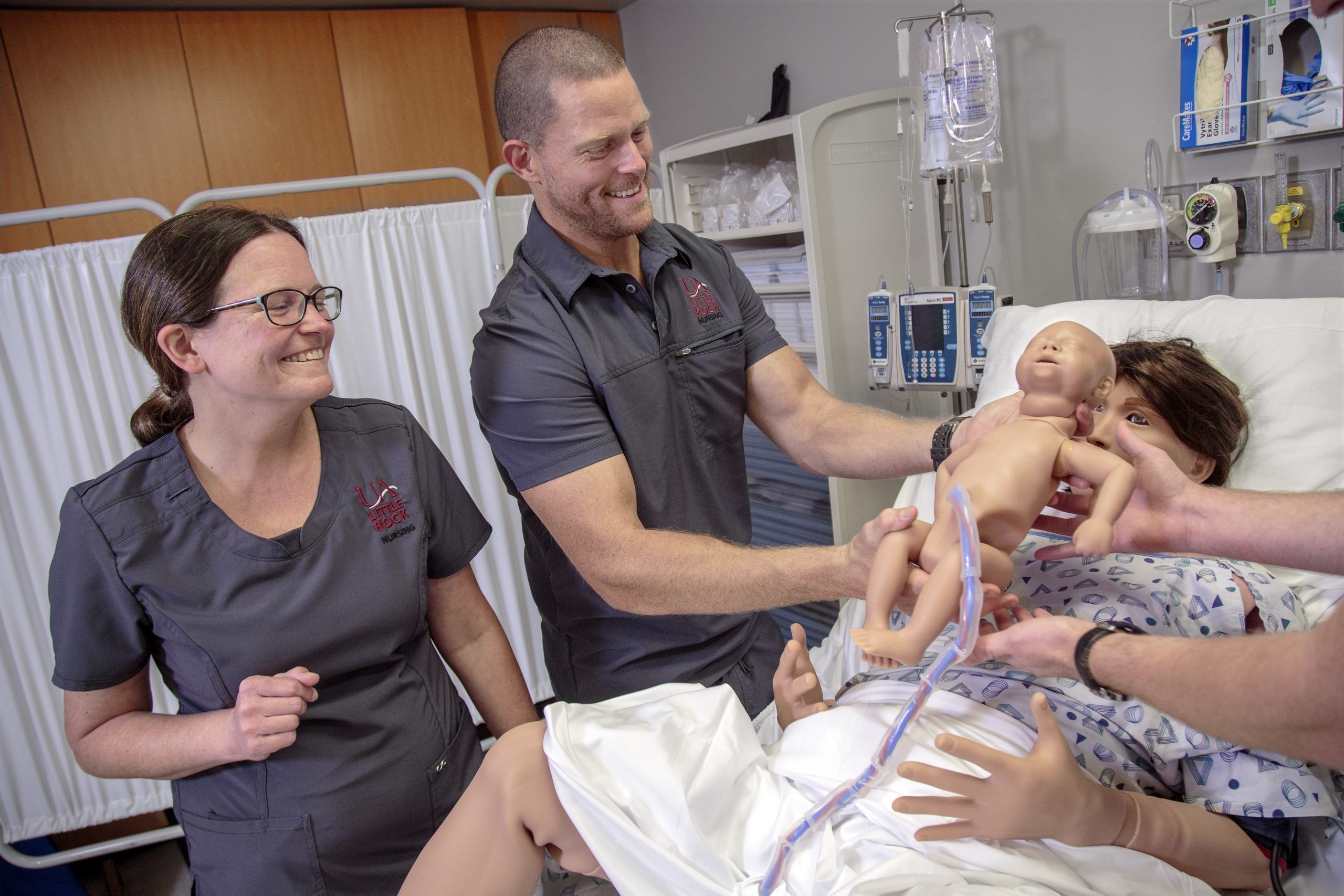New Birthing Manikin Provides Lifelike Training for UA Little Rock Nursing Students

The addition of a new birthing manikin simulator to UA Little Rock is ensuring that nursing students are getting the hands-on experience they need to care for patients in Arkansas.
The UA Little Rock School of Nursing is now home to the Lucina AR Childbirth Simulator, which provides simulation experiences for all stages of delivery and rare emergency scenarios with incorporation of augmented and virtual reality components. Lucina is funded in part by a grant from the Willard and Pat Walker Charitable Foundation.
“She is the most state-of-the-art birthing manikin in the world,” said Joanna Hall, director of the Center for Simulation Innovation. “Lucina feels and looks more real and helps increase the realness of the simulations for our students. She also comes with virtual and augmented reality features that bring more learning capabilities to our training simulations.”
Lucina gives birth to her baby multiple times a day to give nursing students a first-hand look at deliveries and the emergency situations that can arise, such as preeclampsia-induced seizures, a breech birth, and fetal shoulder dystocia. In addition, Lucina’s baby can also be used in training scenarios involving newborns to six-month-old babies.
“We work hard to prepare our students for the workforce from the jump,” Hall said. “We put out exceptionally qualified nursing students who are prepared to pass their licensure exams and be safe, skilled nurses who can take care of the people in our community.”
Johni Beth Teague, an assistant professor of nursing and simulation faculty member, said the addition of Lucina has moved the simulation experience to the next level for UA Little Rock nursing students.
“This manikin is the highest fidelity manikin on the market. We utilize her for four different simulations throughout the day,” Teague said. “She not only provides a realistic birth experience, but she also can provide realistic complications from labor and the prepartum and postpartum period. The ability for her to also offer virtual and augmented reality takes the student’s experience down to the pathophysiological level to help them understand what is going on from a cellular level. Lucina functions on her own server, which allows for uninterrupted simulations due to technology glitches or server overload while other scenarios are running.”
Students can get an inside look at the health situation using Lucina’s virtual and augmented reality features, which provides a 360-degree, holographic view of labor. Students can put on glasses that will allow them to see what contractions look like as they are happening in real time. In addition to seeing what is happening inside of the manikin, the virtual reality feature allows students to experience completely immersive virtual simulations.
“The virtual reality component has a lot of potential in training simulations,” Hall said. “Once you put the goggles on, the experience is completely virtual. You feel like you can touch it, but it’s all playing out like a virtual reality game right in front of you. We can take those goggles anywhere, so there is a lot of potential going forward to help prepare our nursing students and to educate people working in the healthcare industry.”
Sylvia Shaw, a nursing student from Oklahoma City, said the realistic simulation is something she’s never experienced prior to using Lucina.
“This simulation helps prepare you for your nursing career because it gives you the most realistic version of what happens to the body in certain situations,” Shaw said. “It also is able to explain things in detail and show specific organs associated with the disease process. Being able to experience that enhances your understanding and knowledge beyond what can be comprehended from reading a textbook. That kind of experience is something you could never get with just a regular sim manikin.”
UA Little Rock is home to the second largest associate degree program in nursing in the state. Approximately 300 new students begin every summer, and every one of them learns necessary skills for transition to nursing practice in the Center for Simulation Innovation.
“We have a fully functioning simulation hospital in the Pat Walker Center for Nursing Education Building,” Hall said. “We run simulations from 8 a.m. to 5 p.m. five days a week in order to get all of our students through their simulations and get the hands-on experiences they need to learn new skills and graduate.”
The Center for Simulation Innovation also provides a reliable alternative for nursing students who need to complete their training when clinical spots are not available.
“During COVID, a lot of healthcare facilities closed their doors to students to protect their patients,” Hall said. “There were a lot of clinical practice gaps, and we did a lot of virtual clinics and simulations to get our students prepared for the workforce. That is one of the many benefits to a program like ours. While we have great relationships with hospitals and healthcare facilities in central Arkansas, we still plan to use more simulations and implement more simulation experiences for our nursing students going forward.”
